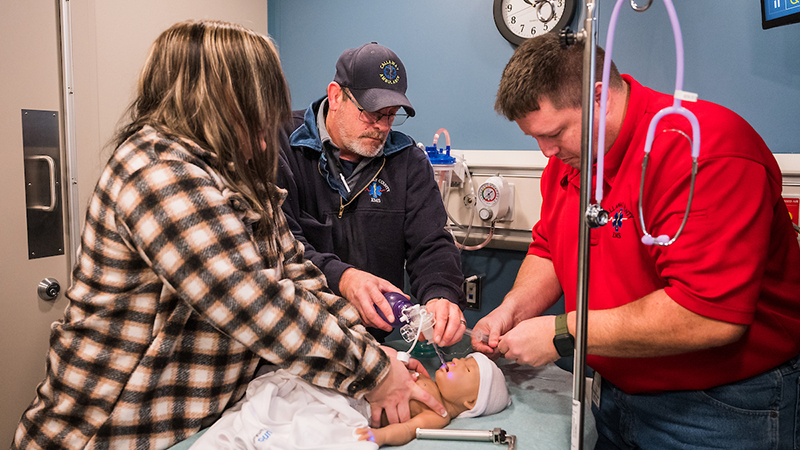
One way to improve health care in Missouri’s rural communities is to expand the skills of local providers. University of Missouri School of Medicine and MU Extension are joining forces to help save lives by taking training on the road to hundreds of Missouri’s rural emergency medical technicians and first responders.
The effort involves a new state-of-the-art mobile simulation unit. This traveling classroom is part of MU’s broader mission to improve medical education in the state.
The 38-foot-long specially equipped truck offers two training rooms and a high-tech control room to run simulations, according to Dena Higbee, MU School of Medicine simulation director.
“Everything you expect to see on the real patient, the simulators will model what is happening to the body as it is being taken care of,” says Higbee.
Emergency responders in Callaway County recently received training during an infant-distress simulation. It was a hands-on exercise that was close to the real thing. And that simulation is just one of more than 100 different life-saving scenarios the mobile unit’s staff can offer, ranging from cardiac arrest and trauma to delivering babies.
Dr. Christopher Sampson, Callaway County EMS medical director, describes the training unit’s value: “High-fidelity mannequins that have pulses, they can breathe on their own, they can show heart rhythms…so when the crews encounter these patients in real life, they are better trained for it.”
Trainings take 30-40 minutes, according to Callaway County EMT Cayce Heiberger. That includes a short debriefing on trainee performance.
“Even if we did mess up,” she says, “we’d rather mess up on a mannequin and then get it right on a real patient.”
Plans call for the custom-built simulation unit to travel around Missouri, offering 20 free-of-charge training sessions between now and July. Costs are covered by a federal grant from the Health Resources and Services Administration.
The unit can provide single-day sessions or be on site for multiple days at rural hospitals, making it one-of-a-kind in the Show-Me State, says simulation director Higbee.
“The demand for rural trainings seems to be relatively high. A lot of times (local EMT units) don’t have access to advanced trainers that we have at the University.”
MU has a simulation center at the medical school in Columbia offering an annual average of 12,000 hours of training for medical professionals. That covers about 750 training activities for 75 clients.
With the addition of the mobile unit, the goal is to train an additional 30 fire fighters, first responders and health care workers each day the unit is in service, says Higbee.





